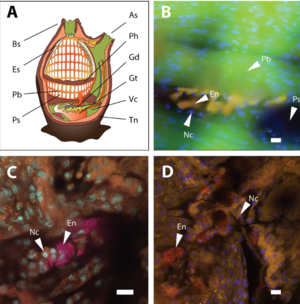Endozoicomonas ascidiicola: Difference between revisions
| Line 43: | Line 43: | ||
==Cell Structure, Metabolism and Life Cycle== | ==Cell Structure, Metabolism and Life Cycle== | ||
E. ascidiicola has a type A1 peptidoglycan. It grows well on full and half-strength marine agar and marine broth, as well as on porcine mucin agar. | Knowledge gaps remain regarding the metabolism and life cycle of E. ascidiicola when inhabiting host ascidians. E. ascidiicola has a type A1 peptidoglycan. It grows well on full and half-strength marine agar and marine broth, as well as on porcine mucin agar. | ||
==Ecology and Pathogenesis== | ==Ecology and Pathogenesis== | ||
Latest revision as of 03:21, 12 December 2024
Classification
Bacteria; Pseudomonadati; Pseudomonadota; Gammaproteobacteria; Oceanospirillales; Endozoicomonadaceae [1]
Species
|
NCBI: [2] |
Genus species
Description and Significance
E. ascidiicola is represented by the type strain AVMART05T and strain KASP37. It is a Gram-negative (KOH positive), motile, rod-shaped bacterium, measuring 0.3–0.7um in diameter and 1.2–11.3um long. Colonies can be beige, circular and convex with a smooth surface and entire margins (strain AVMART05T) or transparent-white, circular and flat with a smooth surface and undulate margins (strain KASP37). Colonies measure 0.5–1 mm (AVMART05T) or 2–3 mm (KASP37) in diameter on marine agar after a 72 h incubation at 25◦C.
E. ascidiicola is mesophilic, neutrophilic, and slightly halophilic, with optimal growth occurring at 23–25◦C, pH 6–7, and 1–2% NaCl. Cells are facultative anaerobic and reduce nitrate.
Genome Structure
E. ascidiicola has a singular, circular genome. The genome contains at least three distinct 16S rRNA gene paralogs. The major cellular fatty acids are C18:1 7c, C16:1 7c, and C16:0. The only detected respiratory quinone is Q-9. The polar lipids comprise phosphatidylglycerol (PG), phosphatidylethanolamin (PE), and one phosphoaminolipid. Most prominent sites of sequence divergence are located in the V2 and V3 region of the 16S rRNA genes. The DNA G+C content is ~47 mol%.
Cell Structure, Metabolism and Life Cycle
Knowledge gaps remain regarding the metabolism and life cycle of E. ascidiicola when inhabiting host ascidians. E. ascidiicola has a type A1 peptidoglycan. It grows well on full and half-strength marine agar and marine broth, as well as on porcine mucin agar.
Ecology and Pathogenesis
Ascidiicola = Ascidian-dweller
E. ascidiicola is a facultative symbiont living within invertebrates, including ascidians. They have also been detected free-living in the seawater, suggesting ascidians can hortizonally acquire these microbes. This particular species is ascidian host-specific. It was first isolated from the pharynx tissue of the ascidian genus Ascidiella collected from Gullmarsfjord, Sweden in 2010. E. ascidiicola is a chemoorganohetherotroph and can grow on pharynx-produced mucin. It can be involved in biogeochemical cylces, including carbon and nitrogen cycling. For instance, E. ascidiicola can break down complex organic compounds derived from host metabolism or surrounding water. They also carry the potential to assist in the transfer of dissolved organic carbon (DOC) from the environment into the host or recycle metabolic waste. Overall, these facultative symbionts can increase host health by recycling nutrients and supporting host metabolism.
References
Schreiber L, Kjeldsen KU, Obst M, Funch P, Schramm A. 2016. Description of Endozoicomonas ascidiicola sp. nov., isolated from Scandinavian ascidians. Systematic and Applied Microbiology 39:313–318.
Schreiber L, Kjeldsen KU, Funch P, Jensen J, Obst M, López-Legentil S, Schramm A. 2016. Endozoicomonas Are Specific, Facultative Symbionts of Sea Squirts. Front Microbiol 7.
Author
Page authored by Grace Kennedy, student of Prof. Bradley Tolar at UNC Wilmington.

